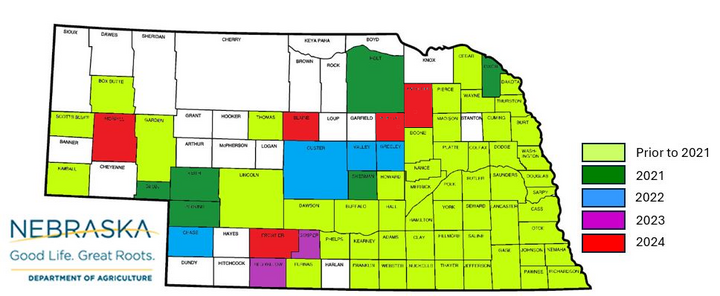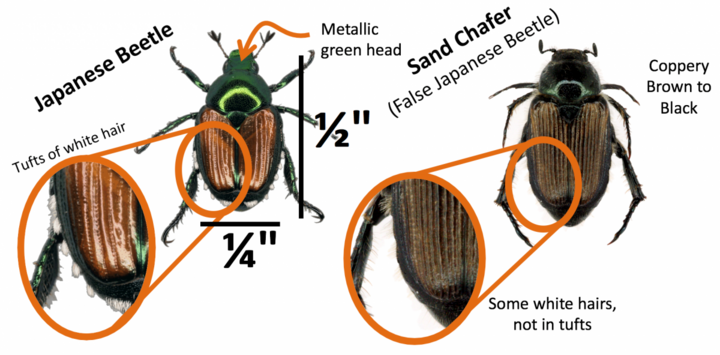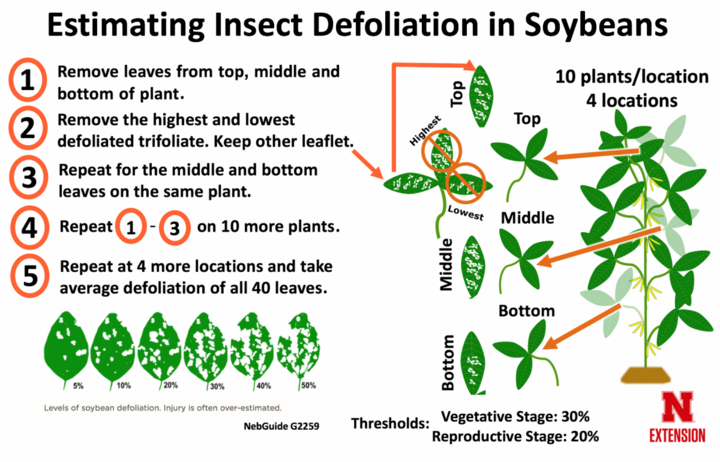Japanese beetle adults (Figure 1) have emerged in Nebraska and while primarily present in landscaping trees, shrubs and flowers, as well as horticultural crops, there has been some recent movement into row crops. Distribution of Japanese beetles has spread across Nebraska over the last 10 years (Figure 2), and they are being seen in corn and soybean more frequently. While you may be concerned about seeing high numbers of beetles along field edges, it is important to realize that economic thresholds are quite high and to avoid unnecessary insecticide applications that could lead to spider mite outbreaks.

Identification and Biology
Japanese beetles have one generation per year. They often feed in clusters due to attraction to the female sex pheromone and volatile chemicals produced by damaged plants. Japanese beetle adults are about ½ inch long and have a metallic green head and thorax (Figure 1 and 3). A key characteristic is a series of white tufts of hair on each side of the abdomen.
In some cases, people have mistaken the Japanese beetle for its look-alike, the false Japanese beetle, or sand chafer, Strigoderma arboricola, which is a native Nebraska insect found across most of the state. Sand chafers (Figure 3) are commonly found along the Platte River valley and other river valleys in Nebraska.
False Japanese beetle adults are about the same size as Japanese beetles, but do not have a metallic green head. They may vary in color from coppery brown to black. They may have some white hairs on the side of the abdomen, but they are not organized into tufts of hair (Figure 3).
Sand chafers are often noticed because they have a habit of landing on people and seem to be attracted to people wearing light-colored clothing. They have not been reported to cause economic damage to crops as adults, although the immature white grub has been reported to cause damage to potato tubers.

Crop Damage and Scouting

Soybeans
Japanese beetles can contribute to defoliation in soybean, along with a complex of other insects, such as bean leaf beetles, grasshoppers and several caterpillar species. They feed by skeletonizing the leaves, leaving only the leaf veins (Figure 4). They feed primarily in the upper canopy, making the damage very visible.
In soybean, insecticide treatment is recommended when insects are present and damage is expected to exceed 30% defoliation in vegetative stage and 20% in reproductive stage soybeans.
For more information, see “Managing Soybean Defoliators” (Nebraska Extension NebGuide G2259). Figure 5 describes a process to accurately assess defoliation levels in soybean by sampling from all portions of the canopy. Be aware that Japanese beetle numbers are often highest on field margins, so scout across the whole field before making a treatment decision.

Corn
In corn, Japanese beetles will scrape off the green surface tissue on leaves before silks emerge but prefer silks once they are available (similar to corn rootworm beetles). Japanese beetles feed on corn silks and may interfere with pollination if abundant enough to severely clip silks before pollination.
Be aware that Japanese beetle numbers are often highest on field margins, so scout across the whole field before making a treatment decision. An insecticidal treatment should be considered during the silking period if:
- There are three or more Japanese beetles per ear,
- Silks have been clipped to less than ½ inch, AND
- Pollination is less than 50% complete.
Treatment Recommendations
If you are above the economic thresholds as described above, a key consideration is avoiding flaring of spider mites.
Products containing the following active ingredients are labeled for use against Japanese beetles in corn:
- Alpha-cypermethrin
- Bifenthrin
- Carbaryl
- Chlorantraniliprole+bifenthrin
- Cyfluthrin
- Deltamethrin
- Gamma-cyhalothrin
- Lambda-cyhalothrin
- Spinosad+gamma-cyhalothrin
- Zeta-cypermethrin
- Zeta-cypermethrin+bifenthrin
Products containing the following active ingredients are labeled for use against Japanese beetles in soybean:
- Alpha-cypermethrin
- Alpha-cypermethrin+acidopyropen
- Beta-cyfluthrin
- Bifenthrin
- Bifenthrin+acetamiprid
- Bifenthrin+imidacloprid
- Chlorantraniliprole
- Chlorantraniliprole+bifenthrin
- Clothianidin
- Cyfluthrin
- Deltamethrin
- Esfenvalerate
- Gamma-cyhalothrin
- Imidacloprid+beta-cyfluthrin
- Imidacloprid+cyfluthrin
- Imidacloprid+lambda-cyhalothrin
For more information, see product labels or the "Insecticides for Field Crops" section from “Guide for Weed, Disease and Insect Management in Nebraska” (Nebraska Extension NebGuide EC130) Nebraska Extension EC130 for rates and restrictions.

